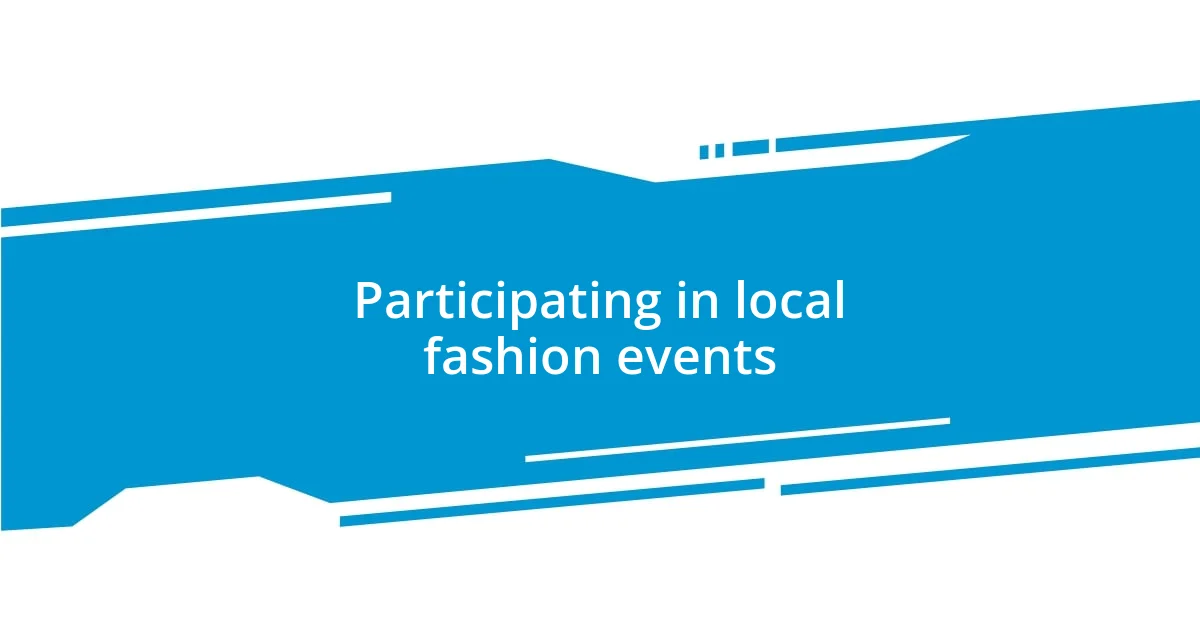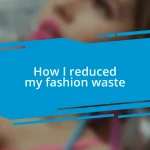Key takeaways:
- Transitioning from fast fashion to sustainable choices emphasizes quality, ethical sourcing, and the story behind each garment, promoting a mindset that values longevity.
- Engagement in local initiatives, such as vintage shopping and participating in eco-fashion events, fosters community connections and supports sustainable practices.
- Educating others about the impact of fast fashion and sharing personal experiences in sustainability can drive awareness and inspire positive changes in consumer behavior.

Understanding sustainable fashion initiatives
Sustainable fashion initiatives are all about creating a system that prioritizes the environment while ensuring ethical practices in the clothing industry. I remember discovering the stark contrast between buying fast fashion and investing in responsibly made garments; it was eye-opening. Have you ever thought about the journey your clothes take before they end up in your closet?
These initiatives often focus on using eco-friendly materials, reducing waste, and promoting fair labor practices. I started to feel a sense of responsibility every time I shopped after learning that my choices could uplift artisans worldwide or contribute to harmful practices. Could your next purchase be a statement of support for crafters who put love into their work instead of relying on exploitative processes?
Moreover, sustainable fashion encourages a mindset shift – moving from a “buy, wear, discard” mentality to one that values longevity and quality. I’ve found that investing in timeless pieces not only benefits the planet but also simplifies my wardrobe. It’s refreshing, isn’t it, to think about how we can all make conscious choices that resonate with our values?

My personal sustainable fashion journey
I’ve been on a transformative journey with sustainable fashion, and it all started with a single vintage dress I stumbled upon at a flea market. The moment I tried it on, I felt a connection to the past and the craftsmanship that went into making it. That experience sparked a realization for me: each piece of clothing tells a story, and I wanted to be a part of a narrative that valued creativity over consumerism.
As I delved deeper, I began to replace impulsive buys with carefully chosen items that aligned with my values. One of my favorite purchases now is a handwoven bag made by artisans in a small community. It’s not just an accessory; it’s a conversation starter that allows me to share the importance of supporting those who invest their time and skills into sustainable practices. Have you ever thought about how your clothing can positively impact lives beyond your own?
Engaging in sustainable fashion has reshaped my priorities. I now focus on quality over quantity, appreciating the artistry behind each piece. Gone are the days of accumulating clothes that fade in a season—each addition to my wardrobe feels intentional and meaningful. This journey has become more than just a trend; it’s a commitment to fashion that respects our planet and its people.
| Traditional Fashion | Sustainable Fashion |
|---|---|
| Fast production cycles | Careful, ethical sourcing |
| Disposable mindset | Value longevity and quality |

Choosing eco-friendly materials
Choosing eco-friendly materials is a crucial step in supporting sustainable fashion. I remember the first time I chose organic cotton over conventional fabric—I felt proud knowing that my choice helped reduce pesticide use and supported healthier farming practices. It wasn’t just about fabric; it was about making a statement. Every time I see that soft, cozy material, I’m reminded that my clothing choices can impact the planet positively.
When it comes to selecting eco-friendly materials, it’s essential to consider their production processes and environmental impact. Here are some materials I often look for:
- Organic Cotton: Grown without harmful chemicals, it protects the soil and supports biodiversity.
- Tencel: Made from sustainably sourced wood pulp, it’s biodegradable and produced in a closed-loop process.
- Hemp: Requires minimal water and pesticides, making it one of the most eco-friendly fibers available.
- Recycled Fabrics: Utilizing waste materials significantly reduces environmental impact—think recycled polyester from plastic bottles!
- Bamboo: Fast-growing and highly renewable, bamboo is naturally anti-bacterial and biodegradable.
Each piece I choose that incorporates these materials feels like a small victory. It’s an opportunity to celebrate my commitment to fashion that honors both personal style and the planet’s health.

Supporting ethical fashion brands
When I advocate for ethical fashion brands, I often think back to my first encounter with a small sustainable label that sources its materials locally. I felt an instant connection the moment I slipped on one of their pieces; it was as if I was wearing a part of a community’s story. Supporting such brands isn’t merely about purchasing clothes; it’s about empowering artisans and encouraging practices that prioritize fair wages and safe working conditions. Have you ever considered how your wardrobe choices could help uplift an entire community?
As I explore ethical fashion further, I find myself gravitating towards brands that embrace transparency in their production processes. One brand I cherish openly shares information about the artisans behind their collections, allowing me to appreciate the skill and love that goes into each stitch. It makes me wonder—what kind of impact can our informed choices have on shaping a more responsible fashion industry? Every time I choose to support these brands, I feel like I’m contributing to a larger movement toward sustainability and equity, which adds a layer of meaning to every purchase.
I’ve also realized that recommending ethical brands to friends and family can spark meaningful conversations about fashion’s broader implications. The discussions that arise often lead to shared discoveries of beautiful, sustainable pieces and, more importantly, the values behind them. Whether it’s a unique pair of shoes crafted from upcycled materials or a stunning dress made by a women-led cooperative, these finds have become not just wardrobe staples but the focal point of numerous animated dialogues. Each purchase is a chance to inspire others and promote a mindset that values ethics over excess.

Promoting second-hand and vintage shopping
Finding second-hand and vintage clothing is like embarking on a treasure hunt, each piece holding its own history and charm. I vividly recall discovering a vintage denim jacket at a local thrift store, its worn edges giving it character that new clothing often lacks. It made me ponder—how many stories did it hold before ending up in my closet? Shopping second-hand not only allows me to express my unique style but also supports a more sustainable fashion cycle by reducing waste.
Every time I choose pre-loved items, I feel a connection to both the past and the planet. For instance, I often think of a stunning patterned dress I found at a vintage market. It’s not just the one-of-a-kind design that thrills me; it’s the knowledge that by choosing vintage, I’m helping to reduce the demand for new clothing production, which can be resource-intensive. Have you ever considered how each second-hand purchase contributes to conserving our environment?
Encouraging friends to explore thrift shops and vintage stores has been a rewarding experience. I love sharing the joy of finding unique pieces that tell a story—it’s like inviting them on a nostalgic journey through fashion. Each time a friend finds that perfect shirt or quirky accessory, I can’t help but feel thrilled for them. It’s amazing to think—could these small shifts in our shopping habits inspire wider change in the fashion industry? It’s a delightful realization that, together, we can make sustainable choices that uplift both our wardrobes and the environment.

Educating others on sustainable practices
When I meet new people, I often find myself sharing what I’ve learned about sustainable fashion. I vividly remember a recent conversation with a colleague who had no idea about the impact of fast fashion on our planet. As I explained how certain brands contribute to pollution and poor labor conditions, I could see the wheels turning in their mind. It feels rewarding to help others connect the dots and realize that their choices matter. Have you ever thought about how knowledge can be a powerful catalyst for change?
I’ve also taken part in local workshops focused on sustainable practices, where I not only learn but also share my insights on ethical consumption. Teaching others about the importance of lifecycle thinking—understanding where clothes come from, how they are made, and what happens to them at the end of their life—is enlightening. One memorable moment for me was leading a discussion on mending clothes instead of discarding them. The enthusiasm in the room as we exchanged tips and even shared our own mending journeys was exhilarating. It made me wonder: how much could we reduce waste if we all embraced the art of repair?
Volunteering at community events that center on sustainable fashion has opened up new pathways for educating others. Recently, I helped organize a small event where people brought in clothing they no longer wore. Seeing the excitement on their faces as they learned how to upcycle those items was unforgettable. It reminded me that small steps lead to bigger changes. Can you imagine how sharing these experiences can ripple outwards, transforming not just our wardrobes but the overarching mindset about sustainable fashion? Each interaction feels like planting seeds of awareness that’ll blossom into a culture of respect for our planet.

Participating in local fashion events
Participating in local fashion events has been a transformative experience for me. I remember the electric atmosphere at a recent eco-fashion show, where the creativity of designers was on full display. It was heartening to see how many people were passionate about using sustainable materials and ethical labor practices. I couldn’t help but wonder—how many more people would embrace eco-conscious choices if they knew about the brilliance behind these events?
Every interaction I had with fellow attendees added another layer to my understanding of sustainable fashion. One of my favorite moments was chatting with a local designer about her inspiration from nature. She spoke with such fervor about her commitment to reducing waste in her production process, and seeing her passion made me realize the importance of supporting these artists. This sense of community strengthens our collective resolve; I often think about how we can uplift each other’s efforts in an industry that can sometimes feel isolating.
Being involved in these local initiatives allowed me not only to engage with sustainable practices but also to share my own experiences. I participated in a clothing swap event, where I brought pieces I no longer wore. Watching others dive into the racks, discovering treasures while I did the same, was exhilarating. It left me with a lasting question: what if more communities embraced such events as a way to redefine our relationship with fashion? Each exchange felt like a tiny act of rebellion against the conventional, fast-fashion cycle, and I felt genuinely proud to be part of that movement.















